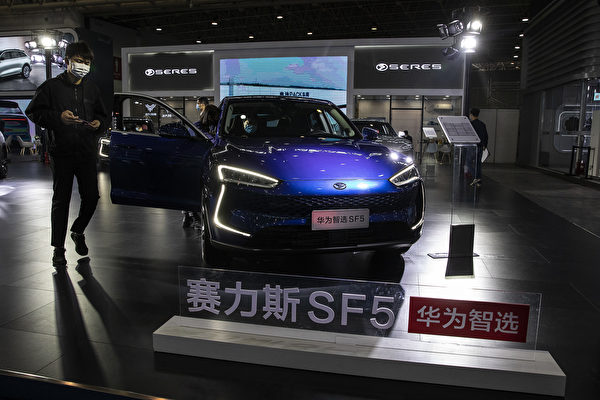A fatal rear-end collision involving a Huawei-owned AITO M7 has resulted in the deaths of three individuals, sparking public outcry and scrutiny. The incident, which occurred on a highway in Shanxi on April 26, where the AITO M7 rear-ended a sprinkler truck, claimed the lives of the driver and two passengers. Questions have arisen regarding the failure of the vehicle’s Automatic Emergency Braking System (AEB) and automatic door unlock function to activate during the accident.
According to reports by “China Business News,” family members of the victims revealed that the vehicle had been purchased just three months prior to the incident, specifying the model as the official-priced AITO New M7 Plus rear-wheel-drive 5-seater version from 2024. AITO later acknowledged that the involved vehicle was indeed the AITO M7 Plus.
The safety of the AITO M7 has been called into question by the victims’ families, raising concerns about the responsiveness of features such as AEB emergency braking and GAEB automatic emergency braking for irregular obstacles, the effectiveness of the safety airbags, and the failure of the retractable door handles to deploy during the accident. Additionally, the families also question why a sprinkler truck was occupying a lane on the highway, leading to the incident.
The incident garnered significant attention, with discussions focusing on the inability to open the rear doors post-accident and the failure of the hidden door handles to deploy.
Despite Huawei’s claims that the high-end intelligent driving system is only supported in the AITO New M7 Max version, information from an automotive website suggests that both the AITO New M7 Plus and AITO New M7 Max utilize the Huawei HarmonyOS operating system and the Huawei Kirin 990A chip for in-car intelligence.
Upon investigation on the AITO official website, it was found that both the “AITO M7” and “AITO New M7” models are equipped with the Huawei intelligent driving system, with the “AITO New M7” model featuring the Huawei ADS 2.0 advanced intelligent driving system (HarmonyOS).
The AITO New M7 is advertised to have a portion of its body structure made of “submarine-grade ultra-high-strength hot-formed steel,” eight standard safety airbags, and emergency braking capabilities.
In July 2022, Huawei collaborated with SAIC Motor to launch the AITO M7 (a hybrid SUV model), marking the second vehicle under Huawei’s AITO brand with the Huawei intelligent cabin system. Due to poor market performance, Huawei and SAIC Motor introduced the “AITO New M7” in September 2023.
On April 28, AITO asserted that the involved vehicle was not equipped with Huawei’s high-end intelligent driving assistance system but instead utilized a Bosch solution. AITO’s response was perceived as an attempt to shift blame.
However, Bosch China issued a statement that evening refuting any involvement in the AITO intelligent driving system. Following Bosch’s denial, official media outlets turned their attention towards another relatively unknown tech company.
Following the incident, an article by “21st Century Economic Report” titled “Reflections on the AITO M7 Accident: ‘Exaggerated Publicity’ Backfires, the ‘Far Ahead’ Comes at a Cost of Life” pointed out several issues warranting contemplation in the wake of the accident.
The article addresses concerns about potential exaggerated advertising by AITO, referencing instances where the vehicle’s structural integrity and AEB function were touted. AITO’s failure to address the lack of response from the hidden door handles post-accident raises questions about potential safety design flaws when incorporating such features.
The piece also discusses the broader implications of the incident, suggesting that industry players may have been pressured into fueling overhyping and paints a cautionary tale for the automotive sector.
Victims’ families, who were reportedly not contacted by Huawei, AITO, or SAIC Motor following the accident, expressed doubts about the companies’ transparency and handling of the situation. Lack of communication and cooperation post-accident led to suspicions about potential cover-ups or downplaying of the incident.
Following reports of “21st Century Economic Report” requesting the removal of their article, speculation arose about external pressures influencing media coverage in China.
In light of the AITO M7 incident, public commentator Wang Yajun remarked on the influence and control Huawei wields, implying that the company’s associations could influence testimonies and outcomes. The incident also highlights concerns about potential corporate interference and manipulation in legal proceedings surrounding the AITO brand.
The collaboration between Huawei and SAIC Motor on AITO has raised speculations about the extent of Huawei’s involvement in the brand’s products and messaging. Despite Huawei founder Ren Zhengfei’s denials of Huawei’s foray into the automotive industry, the actions of AITO and its association with Huawei branding have ignited skepticism.
Reports indicate that Huawei engages with automakers through three models of cooperation, ranging from component supply to branding and marketing integration, with the AITO series falling under the Huawei Smart Selection Car model, emphasizing Huawei’s involvement in design, technology solutions, marketing, and sales for the vehicles.

